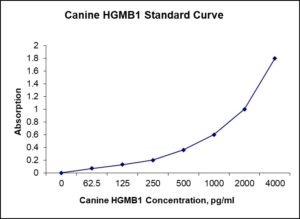Nori Canine HMGB1 ELISA Kit
$461.00 – $832.00
This ELISA kit is for quantification of HMGB1 in dog. This is a quick ELISA assay that reduces time to 50% compared to the conventional method, and the entire assay only takes 3 hours. This assay employs the quantitative sandwich enzyme immunoassay technique and uses biotin-streptavidin chemistry to improve the performance of the assays. An antibody specific for HMGB1 has been pre-coated onto a microplate. Standards and samples are pipetted into the wells and any HMGB1 present is bound by the immobilized antibody. After washing away any unbound substances, a detection antibody specific for IHMGB1 is added to the wells. Following wash to remove any unbound antibody reagent, a detection reagent is added. After intensive wash a substrate solution is added to the wells and color develops in proportion to the amount of HMGB1 bound in the initial step. The color development is stopped, and the intensity of the color is measured.
Alternative names for HMGB1: High mobility group box 1 protein, high-mobility group protein 1 (HMG-1) and amphoterin
This product is for Laboratory Research Use Only not for diagnostic and therapeutic purposes or any other purposes.
- Description
- How Elisa Works
- Product Citation (0)
- Reviews (0)
Description
Nori Canine HMGB1 ELISA Kit Summary
Alternative names for HMGB1: High mobility group box 1 protein, high-mobility group protein 1 (HMG-1) and amphoterin
Alternative name for canine: dog
| Assay Type | Solid Phase Sandwich ELISA |
| Format | 96-well Microplate or 96-Well Strip Microplate |
| Method of Detection | Colorimetric |
| Number of Targets Detected | 1 |
| Target Antigen Accession Number | Q6YKA4 |
| Assay Length | 3 hours |
| Quantitative/Semiquantitative | Quantitative |
| Sample Type | Plasma, Serum, Cell Culture, Urine, Cell/Tissue Lysates, Synovial Fluid, BAL, |
| Recommended Sample Dilution (Plasma/Serum) | No dilution for sample <ULOQ; sufficient dilution for samples >ULOQ |
| Sensitivity | 12 pg/mL |
| Detection Range | 62.5-4000 pg/mL |
| Specificity | Canine HMGB1 |
| Cross-Reactivity | < 0.5% cross-reactivity observed with available related molecules, < 50% cross-species reactivity observed with species tested. |
| Interference | No significant interference observed with available related molecules |
| Storage/Stability | 4 ºC for up to 6 months |
| Usage | For Laboratory Research Use Only. Not for diagnostic or therapeutic use. |
| Additional Notes | The kit allows for use in multiple experiments. |
Standard Curve
Kit Components
1. Pre-coated 96-well Microplate
2. Biotinylated Detection Antibody
3. Streptavidin-HRP Conjugate
4. Lyophilized Standards
5. TMB One-Step Substrate
6. Stop Solution
7. 20 x PBS
8. Assay Buffer
Other Materials Required but not Provided:
1. Microplate Reader capable of measuring absorption at 450 nm
2. Log-log graph paper or computer and software for ELISA data analysis
3. Precision pipettes (1-1000 µl)
4. Multi-channel pipettes (300 µl)
5. Distilled or deionized water
Protocol Outline
1. Prepare all reagents, samples and standards as instructed in the datasheet.
2. Add 100 µl of Standard or samples to each well and incubate 1 h at RT.
3. Add 100 µl of Working Detection Antibody to each well and incubate 1 h at RT.
4. Add 100 µl of Working Streptavidin-HRP to each well and incubate 20 min at RT.
5. Add 100 µl of Substrate to each well and incubate 5-30 min at RT.
6. Add 50 µl of Stop Solution to each well and read at 450 nm immediately.
Background:
High mobility group box 1 protein, also known as high-mobility group protein 1 (HMG-1) and amphoterin, is a protein that is encoded by the HMGB1 gene.[1] HMG-1 belongs to high mobility group and contains HMG-box domain. Like the histones, HMGB1 is among the most important chromatin proteins. HMGB1 is an intracellular protein that can translocate to the nucleus where it binds DNA and regulates gene expression. HMGB1 supports transcription of many genes in interactions with many transcription factors. It also interacts with nucleosomes to loosen packed DNA and remodel the chromatin. Contact with core histones changes the structure of nucleosomes. It can also be released from cells, in which extracellular form it can bind the inflammatory receptor RAGE. Release from cells seems to involve two distinct processes: necrosis, in which case cell membranes are permeabilized and intracellular constituents may diffuse out of the cell; and some form of active or facilitated secretion induced by signaling through the NFkappaB. HMGB1 can interact with TLR ligands and cytokines, and activates cells through the multiple surface receptors including TLR2, TLR4, and RAGE.[2]] HMGB1 is secreted by immune cells through leaderless secretory pathway.[3] Activated macrophages and monocytes secrete HMGB1 as a cytokine mediator of Inflammation.[4] Antibodies that neutralize HMGB1 confer protection against damage and tissue injury during arthritis, colitis, ischemia, sepsis, endotoxemia, and systemic lupus erythematosus. The mechanism of inflammation and damage is binding to TLR4, which mediates HMGB1-dependent activation of macrophage cytokine release. This positions HMGB1 at the intersection of sterile and infectious inflammatory responses.[5] HMGB1 has been shown to play an important role in helping the RAG endonuclease form a paired complex during V(D)J recombination.
References
Be the first to review “Nori Canine HMGB1 ELISA Kit”
You must be logged in to post a review.






























Reviews
There are no reviews yet.